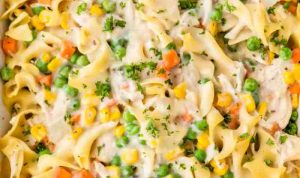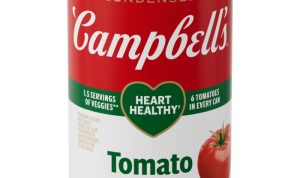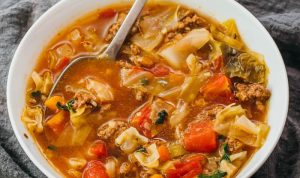Viral Lasagna Soup Recipe Variations
This viral lasagna soup recipe is incredibly versatile. Its core components—ground meat (or vegetarian substitute), pasta, and a rich tomato-based sauce—provide a fantastic foundation for numerous delicious variations. By altering the protein source, cheese type, and vegetables, you can easily customize this recipe to suit your preferences and dietary needs. This section will explore three distinct variations, each featuring a different protein, along with a nutritional comparison and a discussion of the resulting taste and texture differences.
Lasagna Soup Recipe Variations: Protein Sources
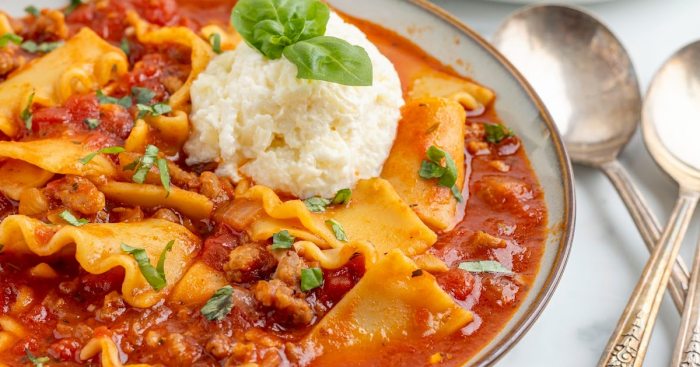
Source: thebestblogrecipes.com
The viral lasagna soup recipe has captured many hearts with its comforting warmth, but for those seeking a similarly satisfying yet simpler option, consider exploring the rich flavors of classic French cuisine. If you appreciate the depth of layered flavors in lasagna soup, you might find a kindred spirit in the delightful simplicity of simple french onion soup recipes , which offer a similar comforting experience.
Returning to the lasagna soup, its popularity underscores our collective love for hearty, flavorful meals.
We will explore three variations, highlighting different protein sources: ground beef (classic), Italian sausage (savory), and a vegetarian option using lentils (hearty).
| Variation | Calories (per serving) | Protein (per serving) | Fat (per serving) | Carbohydrates (per serving) |
|---|---|---|---|---|
| Ground Beef | Approximately 350 | 25g | 18g | 30g |
| Italian Sausage | Approximately 400 | 28g | 22g | 32g |
| Vegetarian (Lentils) | Approximately 280 | 20g | 8g | 40g |
The ground beef version offers a familiar, comforting taste with a slightly richer, fattier texture. The Italian sausage variation adds a deeper, spicier flavor profile and a slightly chewier texture. The vegetarian lentil version provides a hearty, earthy taste with a slightly thicker consistency. The nutritional values are estimates and can vary based on specific ingredients and portion sizes.
Ingredient Sourcing and Substitutions
Choosing high-quality ingredients is key to achieving the best flavor and texture in your lasagna soup. This section will discuss selecting premium ingredients and suitable substitutions for common components.
- Ground Beef/Sausage: Opt for lean ground beef or high-quality Italian sausage for a better flavor profile. Substitutions: Ground turkey, ground chicken, or plant-based meat alternatives (impact on flavor and texture will vary).
- Cheese: Use a blend of mozzarella and Parmesan for the classic lasagna taste. Substitutions: Ricotta, provolone, or a combination of other Italian cheeses. (Flavor and texture will be altered depending on the choice).
- Pasta: Use small pasta shapes like ditalini, elbow macaroni, or small shells. Substitutions: Other small pasta shapes will work, but larger shapes might require longer cooking time. (Texture may differ).
- Tomatoes: Use high-quality canned crushed tomatoes or a combination of canned and fresh tomatoes for a brighter, more vibrant flavor. Substitutions: Tomato puree or passata (will result in a slightly different texture and intensity of flavor).
Cooking Methods and Techniques
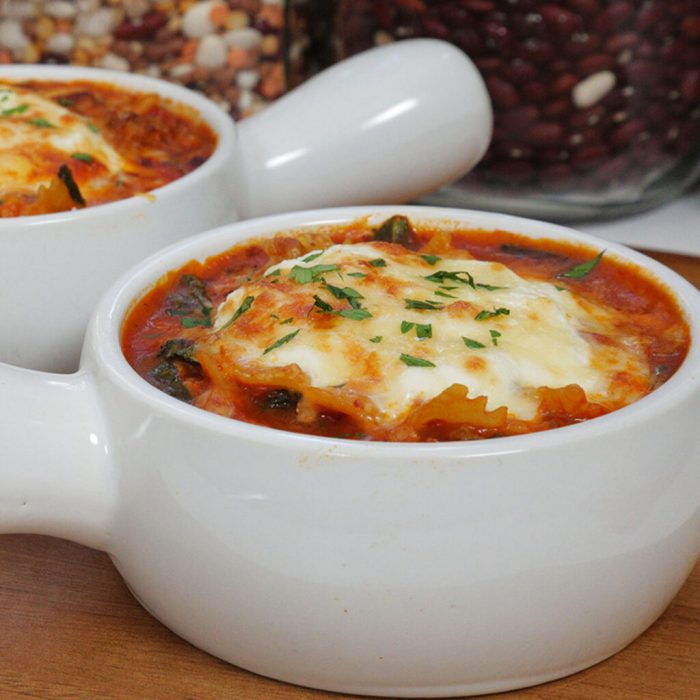
Source: thedomesticgeek.com
This recipe can be prepared using either stovetop or slow cooker methods. Both offer unique advantages, resulting in slightly different textures and flavors. The following table compares both approaches.
| Method | Cooking Time | Texture | Advantages |
|---|---|---|---|
| Stovetop | Approximately 30-40 minutes | Slightly thinner, more vibrant flavor | Faster cooking time, more direct control over heat and consistency |
| Slow Cooker | Approximately 4-6 hours on low | Thicker, richer flavor | Hands-off cooking, allows for deeper flavor development |
To achieve the perfect consistency, simmer the soup until the pasta is cooked through and the sauce has thickened slightly. Adjust the liquid as needed to achieve your desired consistency. Overcooking can result in a mushy pasta; undercooking will leave the pasta firm.
Serving Suggestions and Presentation
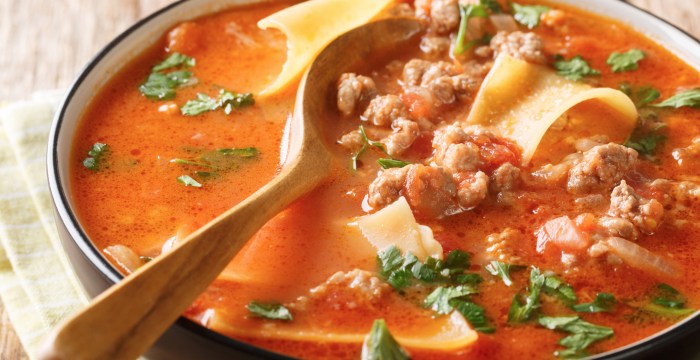
Source: ctfassets.net
Enhance the visual appeal and enjoyment of your lasagna soup with creative serving suggestions and presentation techniques.
- Garnish with fresh basil and grated Parmesan cheese: The bright green of the basil contrasts beautifully with the warm colors of the soup, while the Parmesan adds a salty, creamy element.
- Serve with crusty bread for dipping: The bread absorbs the flavorful broth and adds a satisfying textural contrast.
- Add a dollop of sour cream or crème fraîche: This adds a cool, tangy counterpoint to the warm, savory soup.
Serve the soup in rustic bowls to enhance its rustic appeal. The warm, rich colors of the tomato-based broth, combined with the creamy texture of the cheese and the pops of green from the basil, create a visually appealing and appetizing dish. The contrasting textures of the pasta and the optional bread or sour cream add further depth to the visual experience.
Keep the soup warm by using a warming tray or placing the serving bowl over a small candle warmer. For longer periods, consider using a slow cooker on its “warm” setting.
Recipe Scaling and Storage
This recipe is easily scalable to suit various serving sizes. Proper storage is crucial to maintain the quality and flavor of leftovers.
To scale the recipe, simply multiply or divide all ingredients by the desired factor. For example, to double the recipe, multiply the quantities of all ingredients by two. To halve the recipe, divide all ingredient quantities by two.
Store leftovers in airtight containers in the refrigerator for up to 3 days. For longer storage, freeze the soup in freezer-safe containers for up to 3 months. Thaw the soup overnight in the refrigerator before reheating. Reheat gently on the stovetop or in the microwave, stirring occasionally to prevent scorching. Avoid over-reheating, as this can compromise the texture and flavor.
Dietary Adaptations, Viral lasagna soup recipe
Adapting this recipe to accommodate various dietary needs is straightforward. The following table Artikels modifications for gluten-free, low-sodium, and low-fat diets.
| Dietary Need | Modification | Impact |
|---|---|---|
| Gluten-Free | Use gluten-free pasta | No significant impact on flavor, texture may slightly differ. |
| Low-Sodium | Use low-sodium broth and reduce or omit added salt | May slightly reduce the intensity of the flavor. |
| Low-Fat | Use lean ground beef or turkey, reduce the amount of cheese, and use low-fat milk or cream (if added) | Will result in a lighter, less rich flavor and texture. |
Questions and Answers
Can I use different pasta?
Absolutely! Experiment with different shapes – ditalini, small shells, even broken-up lasagna noodles would work in a pinch. Just make sure they’re small enough to cook through easily.
How long does the soup last in the fridge?
Stored properly in an airtight container, your lasagna soup should last for 3-4 days in the refrigerator. Beyond that, the flavor might start to fade (but it’ll still probably be pretty darn good).
Can I freeze this soup?
Yes! Freeze in airtight containers for up to 2 months. Let it thaw overnight in the refrigerator before reheating gently on the stovetop.
What if I don’t have all the ingredients?
Don’t panic! Many ingredients have suitable substitutions (see the detailed section in the recipe). A little improvisation goes a long way in the kitchen.

